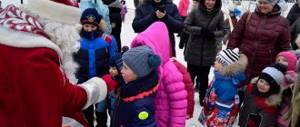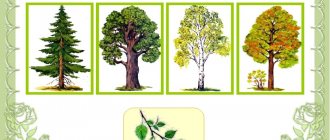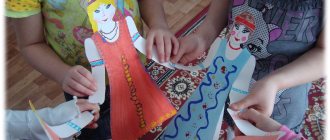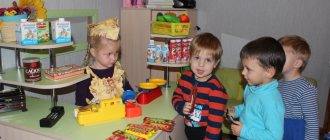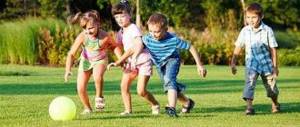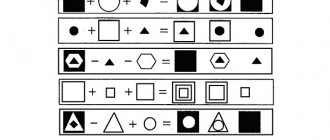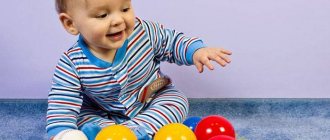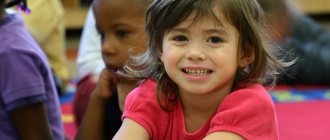Open lesson on sensory development in the senior group. Abstract
Summary of an open lesson on sensory development in the senior group on the topic: “Land of Games - Sensory”
Goal: enriching sensory experience, creating gaming conditions for the development of intellectual abilities. Objectives: - to cultivate emotional responsiveness, politeness, friendliness, and respectful attitude towards others; — develop motor activity, communication skills, interest in experimental activities (social-communicative, physical development); building self-confidence, strengthening the physical and mental health of children (physical development); - help develop his sensory capabilities: visual, tactile. - teach how to apply theoretical lessons in practice. Types of activities: gaming, motor, cognitive-research, social-communicative, productive. Equipment: multimedia projector, 2 easels, colorful balls, chest, colored mugs, colored pencils, sheets of white paper, bags of medicinal herbs, 2 jars (sugar, salt), presentation for the lesson.
Progress of the lesson
Educator: Hello my friends, I’m glad to see you all! Children: Do you want to say hello to the sun, the birds, etc. Children: Teacher: Good morning to the Sun and the birds! Good morning to smiling faces And everyone becomes kind and trusting Let the good morning last until the evening. -Do you like to play? Children: -Do you want to go with me to a wonderful country called “Land of Games - Sensorics!”? Children: Educator: -Do you know how to get to our extraordinary country? Children: -Before I set off, I want to show you something. (The teacher shows a large “chest of sensations”, music from the program “What? Where? When?” plays) Educator: - I suggest you find out by touch what is in the “chest of sensations”. (Those who wish, feel the chest and name what may lie in the chest). And to guess what is in the chest, we need to go on a plane trip. Educator: - Our plane is taking off! (The song “Airplane” from the collection - Children's Songs sounds) Educator: - Well, we landed at the first airport. Rainbow City Presentation “Colorful Country” (slide 2 - 15)
- Can you guess what the city is called?
Children: -Rainbow City. Educator: -And the residents of this city want to teach you how to play their games. “Balls” 1. Children need to collect balls into baskets at the same time with 2 hands, yellow in the right hand, blue in the left. Who will score more? 2. "Colored mugs." Pupils are invited to join the circle. The teacher has 4 mugs of different colors in his hands. When raising the red circle, all pupils must sit down, the yellow circle must jump, the green circle must walk in place, the blue circle must run in a circle one after another. The inhabitants of this country want to help us find out what is in the sensation chest and give us a hint (shows a green card), which means there is a green object in the chest, remember. — Thank you, residents, for showing interesting games that introduce color. And it's time for us to go. (Music sounds, the plane flies further).
— What is the name of this city, let’s guess?
(I’m asking riddles about geometric shapes, showing the presentation (slide 16-20)
1. Three vertices are visible here, Three angles, three sides, - Well, perhaps that’s enough! - What do you see? - Answer: Triangle 2. There are no angles me, And I look like a saucer, Like a plate and a lid, Like a ring, like a wheel. Who am I, friends? Answer: Circle 3. I’m neither an oval nor a circle, I’m a friend to the triangle, I’m a brother to the rectangle, After all, my name is Answer: Square 4. Trace the whole brick with chalk On the asphalt, And you will get a figure - You, of course, are familiar with it. Answer: Rectangle
(The teacher asks the last riddle)
And my brother, Seryozha, Mathematician and draftsman - On Baba Shura’s table Draws all sorts of things Answer: Figures
Educator: -Have you guessed the name of the city? Children: City of “Figures” Educator: -Well done! Game “Recognize and Count"
(slide 21 - 25)
Game “Artist”. Each child is asked to take 2 identical pencils and draw 2 hands at the same time any geometric figure... Then he offers to again, with both hands, complete the details on this figure to form an object. — Thanks to this game, we were able to find out that in the chest there is an object (shows the second and third cards) that is round in shape and small in size. Let's remember! And our plane is calling us forward again! (music sounds) Let's fly on! City of "Cooks". - Look who's meeting us? Children: (slide 26) Educator: - Chefs have a well-developed sense of smell and taste. Game “Taste” I offer the children 2 jars (sugar, salt). Assignment: “Let’s guess what taste?”: let’s try salty, sweet tastes. Game “Bags” I show the children bags with the smells of medicinal herbs. And I suggest that you smell the bag, determine what the bag is filled with and find an image of this filler in the picture (slide show 27-30) - The cook tells us that there is a sweet object in the “chest of sensations”. (shows a drawing at the presentation). Now it's time to guess. Guys, what is in our “chest of sensations”? -That's right, apple! - Well done!!! (The cook gives away all the apples).
We say goodbye to the cook and thank him for the treat.
Educator: Now it's time to go back to kindergarten. We sit down more comfortably and fly. Guys, our journey has come to an end. Reflection. Did you like it? What filled us more in our journey? Children:
We recommend watching:
Summary of educational activities in the senior group “Journey to a Fairy Tale” Summary of a mathematics lesson for children of the senior orthopedic group Summary of educational and gaming activities in the senior group in the section of the “Childhood” program Synopsis of educational activities for the perception of music in the senior group of kindergarten
Similar articles:
Lesson in the senior group of kindergarten on the topic of February 23
Lesson notes for children of senior preschool age. Topic: Invisible air
Summary of organized educational activities for children of the senior group
Notes for mathematics classes in the senior group
Lesson summary on the topic “Reserve” in the senior group
Sensory development of children of primary preschool age; methodological development
Sensory development of children of primary preschool age
Preschool age is the period of initial acquaintance with the surrounding reality; at this time, the child’s cognitive abilities intensively develop. The initial stage of knowledge of the world is sensory experience, which accumulates most intensively in early preschool age. Individual sensations received from an object are summarized into a holistic perception of it. Based on sensations and perceptions, ideas about the properties of objects are formed, it becomes possible to differentiate them, to single out one from many others, to find similarities and differences between them.
Prominent domestic scientist N.M. Shchelovanov called early preschool age the “golden time” of sensory education. The lack of targeted perception distorts children's ideas about the subject.
Sensory development is the development of a child’s perception and the formation of his ideas about the external properties of objects: their shape, color, size, position in space, smell, taste, etc. Knowledge begins with the perception of objects and phenomena of the surrounding world.
Sensory development is the key to successful mastery of any practical activity, the formation of abilities, and the child’s readiness for school.
Sensory education is a targeted pedagogical influence that ensures the formation of sensory experience and the improvement of sensory processes: sensations, perceptions, ideas.
In life, a child encounters a variety of shapes, colors and other properties of objects, in particular toys and household items. The baby is surrounded by nature with all its sensory signs - colors, smells, noises. And of course, every child, even without targeted education, perceives all this in one way or another. But if assimilation occurs spontaneously, without the reasonable pedagogical guidance of adults, it often turns out to be superficial and incomplete. But sensations and perceptions can be developed and improved, especially during preschool childhood. Therefore, it is important to consistently and systematically include sensory education in the routine moments of a preschool educational institution.
Starting from the age of three, the main place in the sensory education of children is to familiarize them with generally accepted sensory standards and ways of using them. The perception of sensory standards is a complex process. Ensuring that children acquire sensory standards means forming in them an idea of the main varieties of each property of an object.
At the same time, the main means of sensory education are gaming technologies. Game pedagogical technology is the organization of the pedagogical process in the form of various pedagogical games. This is the consistent activity of the teacher in:
— selection, development, preparation of games;
— inclusion of children in play activities;
- implementation of the game itself;
- summing up the results of gaming activities.
The types of pedagogical games are very diverse. They may vary:
- by type of activity - motor, intellectual, psychological, etc.;
- by the nature of the pedagogical process - teaching, training, controlling, cognitive, educational, developmental, diagnostic.
- by the nature of the gaming methodology - games with rules; games with rules established during the course of the game; a game where one part of the rules is specified by the conditions of the game, and is established depending on its progress.
- in terms of content - musical, mathematical, socializing, logical, etc.
- for gaming equipment - tabletop, computer, theatrical, role-playing, director's, didactic.
In didactic games, cognitive activity is combined with play. On the one hand, a didactic game is one of the forms of an adult’s educational influence on a child, and on the other hand, a game is the leading type of independent activity of children.
The practice of using didactic games with sensory content has shown that the sensory development of young children occurs most intensively, provided that they should not be carried out occasionally, but in a certain system, in close connection with the general course of sensory training and education of younger preschoolers. The teacher, in joint play activities with children, enriches their sensory experience for a full perception of the world around them. The richer the sensations and perceptions, the broader and more multifaceted the child’s information about the world around him will be.
Thus, one of the central places in working with children is the use of gaming technologies for the development of sensory standards, since the youngest preschool age is the most sensitive to improving the functioning of the senses and accumulating ideas about the world around them. Sensory development, on the one hand, forms the foundation of the child’s overall mental development, on the other hand, it has independent significance, since full perception is necessary for the child’s successful education at school.
Many domestic and foreign teachers and psychologists have paid great attention to research in the field of sensory education of preschool children. In the pedagogical literature, scientists have defined the essence and methods of sensory education in different ways.
Ya.A. was the first to draw attention to the problem of sensory education of children. Comenius in the 17th century. He contrasted verbal education with active education. Comenius considered it necessary to organize the perception of phenomena in the surrounding world by children using all senses. He reflected his views on this problem in his work “The World of Sensual Things in Pictures.”
The first comprehensive system of sensory education for preschoolers was proposed by Friedrich Froebel. He created the manual “Froebel's Gifts”, which had 6 gifts (balls, cubes, cylinders, tiles, etc.). The use of this manual contributed to the development of children's construction skills and formed an understanding of shape, size, spatial relationships, and quantity. A valuable feature of Froebel's Gifts is the consistency in introducing children to geometric shapes, the very idea of building material. The strengths of this system include the inclusion of sensory education tasks in the general tasks of the child’s mental development, recognition of the role of the child himself in mental and sensory development, and provision of systematic guidance of this activity by the teacher. The disadvantage of “gifts” is the abstractness, formalism of the material, the limitations of the entire system of sensory education, practically unrelated to living reality, which limited the children’s horizons and freedom of creativity.
Maria Montessori created a clear, well-thought-out system of sensory education, which is still the basis of programs in kindergartens abroad. She believed that it was impossible to teach a child to think correctly if he himself did not practice correct thinking. For these purposes, a system of sensory exercises should be used. In order to teach a child to think, it is necessary to teach him to compare and group correctly, i.e. correctly discern the surroundings. M. Montessori came up with unusual aids and games with the help of which children explored the world around them in a way that was accessible to them - based on sensory experience. With the help of Montessori didactic material, the senses are exercised. To develop the sense of touch, weight, size, vision, hearing, rhythm, etc. Using her method, objects were made: planks, cubes, cylinders, plates, from various materials. The child had, for example, to insert bars and cylinders of different sizes into the corresponding holes or by touch, blindfolded, to determine the property of the material and its configuration, to name what material the object was made of and what kind of object it was.
In domestic pedagogy, E.I. made a huge contribution to the development of the problem of sensory education of preschool children. Tikheeva. She considered it possible only in certain cases to use special exercises in the so-called “mental orthopedics”, which, with skillful guidance, can contribute to the development of sophistication of perception in children, cultivate endurance, will and observation. These exercises should be associated with practical exercises and games conducted in kindergarten, and they should be constantly varied. She created her original system of didactic materials for the development of the senses, built on the principle of pairing and consisting of various objects familiar to children (two cups, two vases of different sizes, colors, etc.), toys and natural materials (leaves, cones, flowers, fruits, shells, etc.). Children's games and activities in which these didactic materials were used were accompanied by conversations. Leading role in didactic games and activities E.I. Tikheeva was taken to the teacher.
Of interest is the system of didactic and educational games proposed by M.B. Medvedeva and T.P. Babich. This system aims to develop “targeted perception of color, shape and size, object representations, orientation in space, visual attention, analytical-synthetic activity...” and represents a fairly clear and reasonable sequence of work. Thus, the authors propose to formulate ideas about the size of objects in the following way: correlating objects by size, by total volume (matryoshka dolls, pyramids); verbal designation of objects by size: show a long, short path; arranging objects in ascending or descending order; localization of quantity; development of the eye; sense of rhythm; games and exercises to develop visual attention.
In the modern system of sensory education, along with educational activities, a certain place is given to activities of a different nature, which are conducted in the form of organized didactic games. In classes of this kind, the teacher sets sensory and mental tasks for children in a playful way and connects them with play. The development of the child’s perceptions and ideas, the assimilation of knowledge and the formation of skills does not occur in the process of educational activities, but in the course of interesting game actions (hiding and searching, guessing and making riddles, depicting various life situations, competition in achieving results).
Exercises with didactic materials and toys (with sets of geometric shapes, collapsible toys, inserts, etc.) are also important. These exercises, based on the practical actions of each child with the details of didactic toys, materials (assemble, decompose, make a whole from parts, put into a hole of the appropriate shape, etc.), allow you to improve the child’s sensory experience and are useful for consolidating ideas about shape, size , color of objects.
Thus, having analyzed the psychological and pedagogical literature on this issue, we can say that sensory development is carried out only in the process of sensory education, when children purposefully form standard ideas about color, shape, size, the characteristics and properties of individual objects and materials, their position in space, etc., all types of perception develop, thereby laying the foundation for the development of mental activity.
The problem of sensory development is recognized as a priority and is of paramount importance in the development of a child of primary preschool age. At the same time, didactic games play a central role in the development of sensory standards in children.
Analysis of psychological and pedagogical literature on the topic, the results of diagnostics of pupils made it possible to determine the goal of the work: increasing the level of sensory development of younger preschoolers through the use of didactic games and exercises.
In accordance with the goal, the following tasks were set: creating conditions for enriching and accumulating the sensory experience of children in the course of joint object-based play activities between the teacher and children. Creation of a system of didactic games and exercises aimed at developing sensory standards of younger preschoolers. Stimulating the development of different types of children's perception: visual, auditory, tactile, gustatory, olfactory. Maintaining and developing children’s interest in jointly with adults and independently examining objects, and various actions with them. Formation of the ability to compare objects according to basic properties (color, shape, size), establishing identity and difference; selecting pairs and groups of objects based on similar sensory attributes.
In accordance with the objectives, I work with younger preschoolers in the following areas:
— I continue to develop perception, create conditions for children to become familiar with the color, shape, size, and tangible properties of objects; I develop the ability to perceive the sounds of music, nature, and native speech;
— I consolidate the ability to highlight color, shape, size as special properties of objects; group homogeneous objects according to several sensory characteristics: size, shape, color, using a system of didactic games and exercises;
— I improve the skills of establishing the identity and difference of objects according to their properties: size, shape, color, telling children the name of the shape: round, triangular, square, rectangular;
— I improve children’s perception, actively including all senses, and develop imaginative ideas;
— I show different ways of examining objects, actively including hand movements on the object and its parts.
I implement the tasks of sensory education through the use of the following methods, forms and means:
— study of scientific and methodological literature on this issue;
— monitoring the development of ideas in younger preschoolers about sensory standards;
— creation of a subject-spatial environment in the group;
— selection of didactic games, exercises, tasks; — experimental games for the development of all types of perception;
— long-term planning of didactic games for the development of sensory standards;
— development of notes on joint play activities of the teacher and children on sensory education;
- a combination of different forms of work with children: frontal, subgroup, individual;
— organizing independent play activities for preschoolers in a sensory corner;
— increasing the level of knowledge among parents on the sensory development of children.
In the pedagogical process, she paid special attention to creating conditions for the sensory development of children in the process of organizing personality-oriented interaction between an adult and a child, as well as independent activities of children. Free, varied activities in an enriched developmental environment allow the child to show inquisitiveness, curiosity, learn about the environment without coercion, and strive for a creative reflection of what he knows.
In the group, I have created favorable conditions for the sensory development of children and equipped a sensory corner. When organizing the corner, I took into account the following criteria: accessibility; safety; aesthetics; compliance with the age characteristics of younger preschoolers.
In addition, to eliminate the fear of using certain objects or materials, I try to create situations where children have the opportunity to observe the actions of adults - I deliberately transfer children from the position of “observer” to an active position of cooperation. When using objects, I explain and show children how to act in order to eliminate undesirable situations. I always appreciate the achievements of each child, their desire to keep themselves busy with something.
The content of the sensory corner is aimed at developing different types of perception.
To develop tactile sensations, I use natural and waste materials: pine cones, chestnuts, pebbles, beans, plastic corks, various vessels, etc. The ways of using these materials are not limited only to the imagination of the teacher, but also to the children.
To develop the sense of touch, I use samples of materials and surfaces: pieces of fur, different types of fabric and paper; items for creating cold and hot (heating pad, ice trays); bags with different fillings.
To develop fine motor skills of the hands, as well as to become familiar with the various properties of objects, I have made the following didactic games and manuals: “Collect beads”, “Laces”, “Flower Meadow”, “Whisperer”, “Find by touch”, various “ladybugs” , turtles, etc.
To develop auditory perception, in the sensory corner there are aids for creating sounds: these are various voiced toys: a cockerel, a bell; “rustles” made of fir cones; from yogurt cups; “rattlers”, etc. To develop an ear for music, we play musical and didactic games: “Guess what I’m playing”, “Guess where it’s ringing?”, “Who lives in the house”, “Sunshine and rain”. In addition, I use a tape recorder to listen to various melodies and sounds: birdsong, the sound of rain, the babbling of a brook, the cries of animals.
To develop the sense of smell, I use fresh fruits and vegetables, and substances with different smells are placed in the corner: coffee, mint, orange peels, etc. I play games with preschoolers: “Test by taste”, “Guess by smell”.
The “activity center” contains games and aids that develop children’s sensory perceptions:
- games to develop ideas about color (“Tie a string to a ball”, “Mosaic”, “Miracle Train”, “Put a butterfly on a flower”, “Hide the mouse”, “Colored squares”, “Dress up the dolls”);
- form (“Decorate the carpet”, “Hide the mouse”, “Geometric lotto”, “Educational cubes”);
- the size of objects (“Assemble a nesting doll”, “Big and small”, “Beads for mom”).
The corner contains permanent and additional objects, which are added depending on the interests, needs of the children, educational and developmental tasks set by the teacher.
The enrichment of sensual, sensory experience is facilitated not only by the sensory corner, but also by the entire subject-development environment of the group.
For example, in the sports corner there are cubes of different colors, balls of different diameters, ribbed tracks, skittles, bags with different fillings: sand, cereals; tracks with footprints, massage mats, ring throwing, etc. The sports corner is aimed not only at developing physical qualities, but also at consolidating children’s ideas about color, shape, size, and properties of materials: plastic, rubber.
In the art corner for children there is paper of different textures, pencils, brushes, stencils, and coloring books. Children have the opportunity to draw with various visual media on various surfaces.
The group organized the Sand and Water Center. This is a separate table with two slots for basins, the containers of which are filled with sand and water. It is designed to introduce children in an accessible form to the properties of sand and water: dry sand flows, wet sand can be used to make pies; You can make a snowman out of snow; water pours and takes the shape of a vessel.
The construction corner allows children to have fun working with parts of building materials in a variety of ways: tapping a part on a part, putting one on top of another, placing it, applying it. At the same time, they discover their physical properties (the ball rolls, the cube stands stable, the brick stands unsteadily on a narrow short edge). The group contains not only traditional materials for building games, but also non-standard ones - these are ordinary dishwashing sponges, which are wonderful “bricks” for buildings.
Various types of theaters are concentrated in the theater corner: finger theater, mug theater, spoon theater, table theater. Children of this age can act out short excerpts from familiar fairy tales.
As noted above, the material for the games is placed in accessible places. I made sure that in each zone there was enough colorful, attractive material, compactly located at different levels, so that the child could constantly engage in active practical activities that would allow him to realize his plans and receive certain information.
Thus, the conditions created in the group contribute to: stimulation of sensory functions (vision, smell, hearing, touch); development of fine motor skills of the child’s hands; simulation of motor activity; activation of cognitive processes: memory, thinking, attention, perception); relieving muscle and psycho-emotional tension; increasing motivation for independent and experimental activities of preschool children.
Such an organization of a developing subject-spatial environment for children of primary preschool age is the most rational, since it takes into account the main directions of the child’s development and contributes to his favorable development.
Conclusion
So, the development of sensory abilities actively occurs in early preschool age, since numerous studies have proven that this period of a preschooler’s life is the most sensitive for the development of perception.
An analysis of the work carried out showed that as a result of systematic and systematic work on sensory education of children of primary preschool age, a selected system of didactic games and exercises, preschoolers develop skills and abilities that indicate an appropriate level of perception development:
- children successfully identify and take into account color, shape, size, texture and other signs of objects and phenomena when performing a number of practical actions;
- group objects according to the sample according to color, shape, size and other properties;
- correlate dissimilar objects by color, shape, size, texture when choosing from four varieties (either four varieties of color, or four varieties of shape, etc.);
- actively use “objectified” words-names to designate shape (brick, ball, sphere, roof, egg, cucumber), color (grass, orange, tomato, chicken, sky, etc.);
- select objects of the required shape or color for the development of an independent story game (they load bars - “bricks” or cubes of a certain color onto the car; select details of outfits for dolls in accordance with the color of their clothes);
- kids are happy to participate in experimentation activities, showing emotions of joyful surprise and verbal activity.
The presented system of work is aimed not only at the sensory development of the child, but also at the formation of the prerequisites for educational activities, since the tasks aim the child at mastering ways of orienting himself in the world around him.
Thus, timely sensory education at this age stage is the main condition for cognitive development, correct and quick orientation in an endlessly changing environment, emotional responsiveness, and the ability to perceive the beauty and harmony of the world. And the rapid activation of sensory systems is one of the key abilities of a person, the foundations of his full development.
Bibliography.
1. Beilina A., Frebel F.: Games and gaming tools: // Journal of Preschool Education. – 1995. – No. 3. – P. 56 – 59.
2. Wenger L.A. Raising a child’s sensory culture M.: Enlightenment. 1988
3. Gorbunova I. Sensory room in “Ladushki” // Journal of Preschool Education. – 2006. – No. 12 – P. 30
4. Glushkova G. Game or exercise // Journal of Preschool Education. – 2008. – No. 12. – P.29 – 34.
5. Dubrovskaya. N.V. Color and features of its perception by preschool children: // Journal of Preschool Pedagogy. – 2003. – No. 6 (15) – P. 21 – 26.
6. Efremova. N. Learning to distinguish colors and remember their names // Journal of Preschool Education. – 2002. – No. 12 – P. 20 – 21.
7. Plekhanov A., Morozova V. Sensory development and education of preschool children: // Journal of Preschool Education - No. 7 -1995.
8. Poddyakov N.N. Sensory education in kindergarten: M.: Education, 1981.
9. Pilyugina E.G. Classes on sensory education: M.: Education, 1983.
10. Soltseva O. G. Our assistants are the senses. // Magazine Child in kindergarten - No. 3 – 2007
11. Tikheyeva I. E. Preschool age: sensory development and education. // Magazine Preschool Education - No. 5 - 2007
Play and sensory development of an older preschooler
Sensory development of preschoolers is one of the areas in the cognitive and intellectual development of the child.
Sensory education is the purposeful improvement and development of sensory processes (sensations, perceptions, ideas) in children.
One of the means of developing sensory abilities is play. In preschool age, play is of utmost importance in a child’s life. The game manages to attract children's attention to objects that, under normal non-game conditions, do not interest them and on which they cannot focus their attention. A didactic game makes it possible to solve various pedagogical problems in a playful form that is most accessible and attractive to children. Particularly valuable are games with colorful didactic material, toys, pictures that depict objects of the surrounding reality.
For the purpose of sensory development and acquaintance with new knowledge, puzzles, educational games, entertaining tasks and logical exercises are used.
In preschool age, the simplest puzzles used are puzzles with sticks. They are called problems of ingenuity of a geometric nature, since during the solution, as a rule, there is a transformation of some figures into others, and not just a change in their number. These tasks contribute to the expansion of ideas about geometric figures and their size, i.e., the development of sensory abilities and knowledge about the shape and size of objects. To organize puzzles, you need to have a set of ordinary counting sticks in order to compose visual problems from them - puzzles. In addition, you will need tables with figures graphically depicted on them that are subject to transformation. The back of the table indicates what transformations need to be made and what shape should be the result.
Ingenuity tasks and games vary in degree of complexity and nature of transformation. In the course of solving each new task, the child is involved in active mental activity (perception of color, shape, size), trying to achieve the final goal - to modify or construct a spatial figure, which develops the sensory abilities of children.
For children aged 5–7 years, ingenuity tasks can be grouped into three groups:
1. Tasks on making a given figure from a certain number of sticks: make two different squares from 7 sticks.
2. Problems involving changing figures; to solve, you need to remove or add the specified number of sticks.
3. Ingenuity tasks where it is necessary to rearrange sticks in order to modify or transform a given figure.
Children perform the simplest tasks of the first group without difficulty when they daily practice making geometric figures from counting sticks. Such tasks help expand sensory ideas about the shape of geometric shapes and objects. The main goal is to train children in the ability to make geometric shapes from a certain number of sticks, and to use the technique of adding or rearranging. For example, you can offer the following tasks:
1. Make two equal triangles from 5 sticks.
2. Make 4 equal triangles from 9 sticks.
3. Make a square and 2 equal triangles from 5 sticks.
4. From 10 sticks, make 2 squares: large and small.
An adult, while maintaining the entertaining, playful nature of the exercises, should strive to ensure that the children’s practical tests become purposeful, that is, the child must first think about the course of the solution and then act. It is enough to practice 3-4 times, then the children will master the ways of attaching one figure to another so that one or more sides are common. To develop children's ability to plan their train of thought, they should be encouraged to make judgments or act and reason at the same time. This helps in developing children’s coherent speech and enriching their vocabulary with mathematical concepts.
Next, tasks for rearranging figures, you should start with those in which, in order to change the figure, you need to remove a certain number of sticks or rearrange them. In this case, training is aimed at developing in children the ability to think through moves mentally, and fully or partially solve a problem in their minds. In the course of completing tasks, children will master the ability, based on reflection, to suggest a solution, test it practically, try it, look for new ways, and justify it. To teach a child to independently analyze tasks, sufficient sensory experience is necessary.
When working with children aged 6–7 years, the nature of games and tasks involving the transformation of figures becomes more complex. Children can come up with basic ingenuity problems themselves and various tasks for games.
To do this, an adult needs to talk with them about how such tasks and game tasks are invented. Maybe together with your child you can create a new task for the game.
One of the types of puzzles are games for making planar images of objects, animals, birds, houses from special sets of geometric shapes. Sets of figures are not selected arbitrarily; they represent parts of a cut specific figure: a square, rectangle, circle or oval. They are interesting for both children and adults. These are games such as “Tangram”, “Pythagoras”, “Columbus Egg”, “Miracle Crosses”, “Transparent Square”, etc. The success of mastering such games in preschool age depends on the level of sensory development of children. Children should know not only the names of geometric figures, but also their properties, distinctive features, and be able to freely move them in order to obtain a new figure. For example: in the games “Tangram”, “Miracle Crosses” - composing the silhouette figure of a hare, running goose, rocket, robot, and in the game “Transparent Square” - composing a horse, house, etc.
The more complex game “Pythagoras” is used in working with children 6–7 years old in order to develop spatial understanding, imagination, and ingenuity.
All didactic and educational games and ingenuity tasks are used to activate children's thoughts, develop logical thinking, develop the ability to guess, and intelligence, which is necessary for preschoolers for educational activities, and for every person for life. In order to expand the sensory development capabilities of preschoolers, educational and logical-mathematical games are also used. So, in the games “Arrange all the shades”, “Match the cups to the saucers”, “Match the pattern” and “Kuisener’s Sticks” - children enrich their ideas about colors, shades, and color combinations. Children consolidate knowledge about the shape of objects, about geometric figures, about size through games such as “Geocont”, “Fold a Square”, “Color and Shape”, “Transparent Square”, “Make a Picture”, “Relay Race”, etc.
Children are particularly interested in games that contain an element of suspense or surprise, such as “What has changed?” “Which is the count”, “Wonderful bag”; to find the missing figure, to continue a series of figures, signs, to search for the missing figure in the series. Games “Find the extra one”, “Find the missing one”, “How many figures are hidden here?”
The purpose of educational and logical games is to activate the mental activity of children and to “revitalize” the learning process.
When working with children 5–6 years old, they first use simple logical and mathematical games in order to develop their ability to carry out sequential mental actions: analyze, compare by shape, color, size, generalize by one or more characteristics, think purposefully. These tasks are clearly presented in the form of drawings, drawings, and illustrated with objects. While searching for an answer, children can pick up the missing figures, change their places, and rearrange objects. Practical actions make solving a problem easier and make it more convincing. For example:
1. How does one picture differ from another?
2. Find two identical objects.
3. Which figure is extra here and why?
To successfully solve such tasks, it is necessary to develop the ability to generalize a number of figures and objects according to selected features, to compare the generalized features of one series with the features of another, which is possible due to the presence of sensory ideas in children about color, shape, and size.
Gradually, the nature of building games becomes more complex. The tasks change, the patterns to which the depicted figures and objects are subordinated. The main complication is the gradual increase in demands on children, the development of independence, the speed of decision, the ability to prove it, and creativity.
Children's mastery of techniques for solving various logical problems hidden in games creates the basis for their creativity. The use of such entertaining material makes it possible to solve the problems of sensory development of preschool children in an interesting way.
Literature:
1. Wenger L. A. Pilyugina E. G. Education of a child’s sensory culture from birth to 6 years. /ed. L. A. Wenger. M. Enlightenment. 1989./
2. Zaporozhets A.V. Development of perception and activity. / Psychology of sensations and perception. Reader./ ed. Yu. B. Gippenreiter et al. M. 2002.
3. Games and exercises to develop mental abilities in preschool children. A book for kindergarten teachers.
4. Nemov R. S. Psychology. M., VLADOS, book. 1, 2003.
5. Smirnova E. O. Child psychology. M., VLADOS, 2006.
6. Feldshtein D.I. Social development in the space-time of childhood. M.,
7. Moscow Psychological and Social Institute / Flita, 1997.
8. Montessori M. Materials for distinguishing structural surfaces and materials. Key board.
